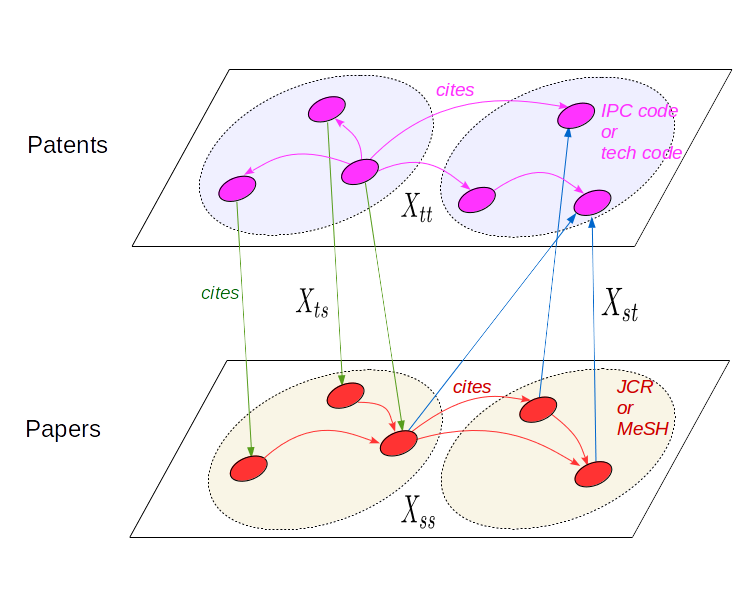分类:科学计量学导引
核心思路和理念
基于网络科学的大科学学
系联、间接影响
从科学(作者、论文、概念)到科学,从科学(论文)到技术(专利),从技术到技术,从科学和技术到产品,从产品到产品,从产品到研发经费,从科学研究到科学的传播和学习
数据框架、问题框架、计算分析方法、实践检验、促进科学技术的发展转播和学习
为了建立这个框架而做的具体研究
本书的写作目的:把科学计量学的研究对象、研究问题和典型思维方式以及分析方法,以及这个学科如何服务于社会和其他学科,用统一的框架呈现出来,促进学科的成熟和发展。将来,这个学科的研究就可以表述成为:在这个基础数据框架(有必要也是可以更新这个数据框架的)上,我们研究什么问题,我们需要什么方法,可以发挥什么作用。
科学计量学的学科大图景
典型研究对象、典型研究问题、典型思维方式、典型分析方法、和世界以及其他学科的关系。暂时见[吴金闪的工作和思考]博客站点上的[什么是科学计量学]。
科学计量学是以科学家(广义的,包含研究科学家、技术发明者、以及相关的期刊出版参与和管理者、科技项目和基金管理者、传播科学的老师、接受传播的学生和大众等)的研究学习和教学活动、科学家活动的结果记录,以及跟这些活动相关的这些记录的审稿、出版、传播以及科学研究项目和基金的管理等,为研究目标,旨在促进科学的发展、科学家的培养和成长、科学的传承和传播,的一门科学。
科学和科学研究
可计算的数学模型,现实,可证伪性和可重复性,尽量忠实尽量简单的表示
概念网络:知识高速公路
概念网络、概念网络与科学研究和科学传播的关系
科学计量学的数据
科学计量学的数据框架
作者-论文-概念三层网络框架,发明人-专利-技术三层网络框架,性别、位置(必要的时候可以成为网络)、期刊等数据作为顶点的属性


科学计量学数据的精炼
作者识别
为什么会有姓名识别的问题?
不完整的名字,相同的名字,工作单位的迁移,研究领域的迁移,聚合和拆分的问题
姓名识别如何做? [1]衡量了最简单的算法——姓的全部和名的第一个字母——的准确率。
姓名识别的结果如何检验?
Orcid数据,ResearchGate数据,官方email数据,各个国家各个学术单位的统计数据,Norwegian模型。
[2]提供了一些可供检验的数据。
引用错误:没有找到与</ref>对应的<ref>标签
</references>
- ↑ 1.0 1.1 Staša Milojević, Accuracy of simple, initials-based methods for author name disambiguation, Journal of Informetrics 7, 767-773(2013). https://doi.org/10.1016/j.joi.2013.06.006 .
- ↑ 引用错误:无效
<ref>标签;未给name属性为Müller:NameData的引用提供文字 - ↑ 3.0 3.1 Christian Schulz, Amin Mazloumian, Alexander M Petersen, Orion Penner and Dirk Helbing, Exploiting citation networks for large-scale author name disambiguation, EPJ Data Science 20143:11 https://doi.org/10.1140/epjds/s13688-014-0011-3 .
- ↑ 4.0 4.1 Jinseok Kim and Jana Diesner, Distortive effects of initial‐based name disambiguation on measurements of large‐scale coauthorship networks, JASIST, 67, 1446-1461(2016). https://doi.org/10.1002/asi.23489 .
- ↑ 5.0 5.1 Wei-Sheng Chin, Yong Zhuang, Yu-Chin Juan, Felix Wu, Hsiao-Yu Tung, Tong Yu, Jui-Pin Wang, Cheng-Xia Chang, Chun-Pai Yang, Wei-Cheng Chang, Kuan-Hao Huang, Tzu-Ming Kuo, Shan-Wei Lin, Young-San Lin, Yu-Chen Lu, Yu-Chuan Su, Cheng-Kuang Wei, Tu-Chun Yin, Chun-Liang Li, Ting-Wei Lin, Cheng-Hao Tsai, Shou-De Lin, Hsuan-Tien Lin, Chih-Jen Lin; Effective String Processing and Matching for Author Disambiguation http://jmlr.org/papers/v15/chin14a.html .
- ↑ 6.0 6.1 Roberta Sinatra, Dashun Wang, Pierre Deville, Chaoming Song, Albert-László Barabási, Quantifying the evolution of individual scientific impact, Science 354(6312), aaf5239(2016), DOI: 10.1126/science.aaf5239 .
- ↑ Waltman, Ludo, A review of the literature on citation impact indicators, JOURNAL OF INFORMETRICS, 10(2) 365-391(2016), DOI: 10.1016/j.joi.2016.02.007 .
- ↑ 吴金闪,狄增如,从统计物理学看复杂网络研究,物理学进展,24(1),18-46(2004).
- ↑ An Zeng, Zhesi Shen, Jianlin Zhou, Jinshan Wu, Ying Fan, Yougui Wang, H Eugene Stanley. 2017. "The science of science: From the perspective of complex systems." PHYSICS REPORTS-REVIEW SECTION OF PHYSICS LETTERS, 714, 1-74 (2017).
- ↑ Carl T. Bergstrom, Jevin D. West and Marc A. Wiseman, The Eigenfactor™ Metrics, Journal of Neuroscience, 28 (45) 11433-11434(2008). DOI: https://doi.org/10.1523/JNEUROSCI.0003-08.2008 .
- ↑ Boyack, K. W., & Klavans, R. (2010). Co-citation analysis, bibliographic coupling, and direct citation: Which citation approach represents the research front most accurately? Journal of the American Society for Information Science and Technology, 61(12), 2389–2404.
- ↑ Waltman, L., & van Eck, N. J. (2012). A new methodology for constructing a publication-level classification system of science. Journal of the American Society for Information Science and Technology, 63(12), 2378–2392.
- ↑ Blei, D. M. (2012). Probabilistic topic models. Communications of the ACM, 55(4), 77–84.
- ↑ Glänzel, W., & Thijs, B. (2017). Using hybrid methods and `core documents’ for the representation of clusters and topics: The astronomy dataset. In J. Gläser, A. Scharnhorst & W. Glänzel (Eds.), Same data—different results? Towards a comparative approach to the identification of thematic structures in science, Special Issue of Scientometrics. doi:10.1007/s11192-017-2301-6 .
- ↑ Mikolov, Tomas; et al. "Efficient Estimation of Word Representations in Vector Space". arXiv:1301.3781.
- ↑ Jeffrey Pennington, Richard Socher, and Christopher D. Manning. 2014. GloVe: Global Vectors for Word Representation.
- ↑ https://radimrehurek.com/gensim/models/doc2vec.html, https://deeplearning4j.org/docs/latest/deeplearning4j-nlp-doc2vec .
- ↑ node2vec: Scalable Feature Learning for Networks. A. Grover, J. Leskovec. ACM SIGKDD International Conference on Knowledge Discovery and Data Mining (KDD), 2016.
本分类目前不含有任何页面或媒体文件。